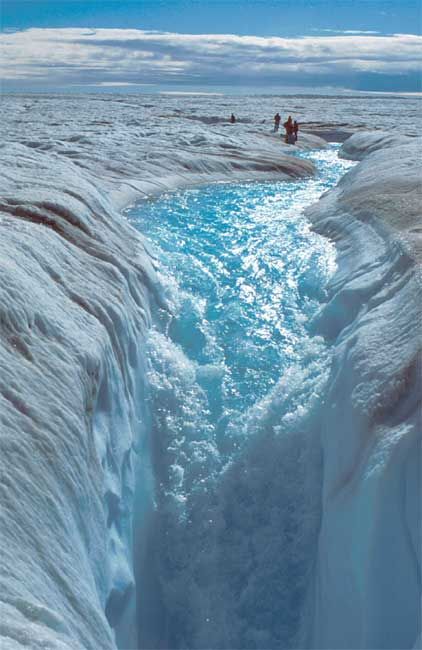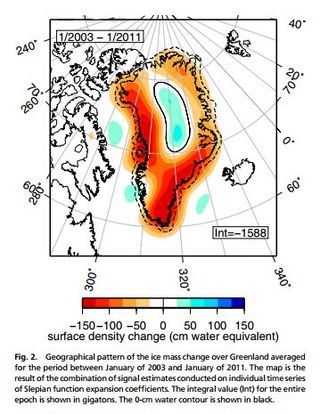
Greenland Ice Melt Accelerating

Picture all of Manhattan covered in a layer of ice that's 11,800 feet (3,600 meters) thick — eight times the height of the Empire State Building. That's the net amount of ice that melts each year in Greenland, according to Princeton University researcher Christopher Harig.
And the rate of ice melt is accelerating.
That annual melt figure comes from a study published online today (Nov. 19) in the journal Proceedings of the National Academy of Sciences, and is based on satellite measurements of Greenland's ice mass from 2002 to early 2011.
Most of the melting comes from glaciers on Greenland's southeast and northwest coasts, satellite measurements show. Surprisingly, ice is accumulating in the hilly center of the island due to higher-than-average levels of snowfall, Harig said.
"It's interesting because that's what is expected when you have a warmer atmosphere," he told OurAmazingPlanet. Unfortunately the gain of ice in the middle of Greenland cannot begin to make up for the net mass lost to melting, he said, which works out to 200 billion tons per year.
Measurements show the rate of melting is accelerating by 9 billion tons each year, Harig said. The study doesn't include measurements from 2012, when a record-breaking amount of ice melted in Greenland.
"I would fully expect when I get that data, it'd show ice loss accelerating even more," he said. "Records keep being broken."
Sign up for the Live Science daily newsletter now
Get the world’s most fascinating discoveries delivered straight to your inbox.
The amount of ice was measured by the GRACE satellites, twin spacecraft orbiting the Earth in an identical path. As the first satellite passes over a Greenland glacier, the massive slab of ice pulls the satellite toward it ever so slightly, changing the distance between the satellites. The same thing happens when the second satellite passes over. By measuring the change in distance between them, the GRACE twins can work out the mass of glaciers and ice and record how it changes over time, Harig said.
If the melting continues at this rate, it would take 13,000 years to melt all of Greenland's ice. But long before that, this amount of melting would cause a significant increase in global sea levels, he said.
Melting of Greenland's ice accounts for about 20 percent of the world's sea level rise, which in total is currently 0.1 inches (3.1 millimeters) per year, Harig said. If Greenland keeps melting at current rates, it alone would lead to a 2.4-inch (6-centimeter) rise in global sea levels over the course of century, he said.
"We're seeing firsthand the effects of the [warmer] climate on the ice," Harig said.

Reach Douglas Main at dmain@techmedianetwork.com. Follow him on Twitter @Douglas_Main. Follow OurAmazingPlanet on Twitter @OAPlanet. We're also on Facebook and Google+.












